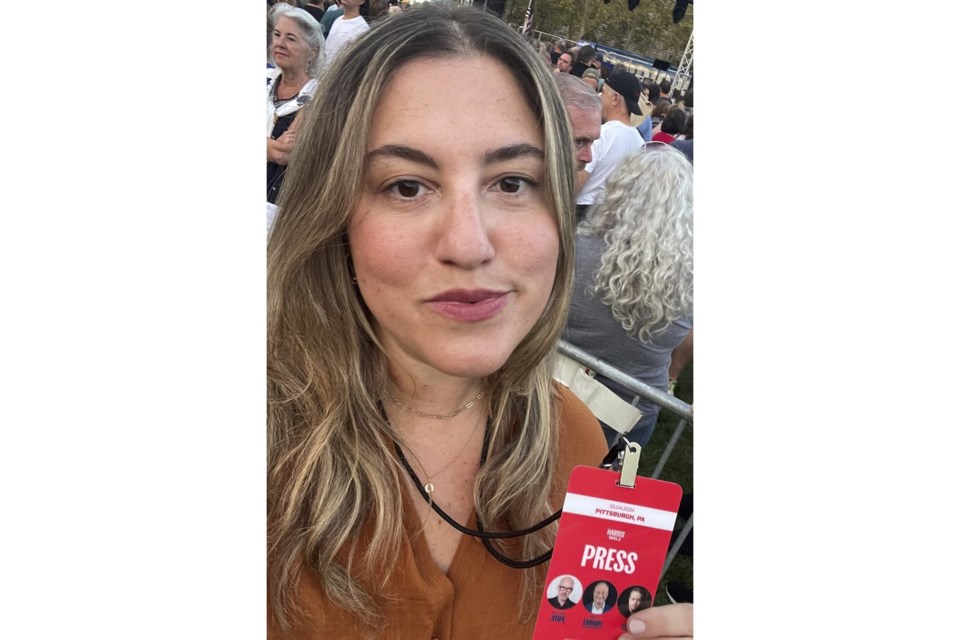First word of the Trump administration's since-rescinded order to freeze spending on federal loans and grants came not from a major news organization, but from a woman working alone in her Brooklyn apartment.
Marisa Kabas' scoop this past week was a key moment for a growing cadre of journalists who work independently to gather and analyze news and market themselves as brands. Many are refugees from legacy outlets while others are scrappy newcomers like Kabas, who found traditional career paths unappealing or out of reach.
“This week has been career-changing,” Kabas said in an interview. “In a sense, my job has changed overnight.”
She was sitting at her kitchen table last Monday, sifting through emails on her laptop, when a source forwarded her a copy of a memo announcing the freeze sent by the Office of Management and Budget's acting director. Kabas has her own website, the Handbasket, but to give the story wider visibility, she posted a screen shot of the memo on the social media site Bluesky.
Then she waited.
Her stomach was in knots. She calmed herself with a walk on a frigid night. Despite her belief in independent journalism — and her own work — she recognized that to many, news only becomes “real” when it appears in a major outlet. Three hours later, The Washington Post published its story, with a hat-tip to Kabas.
The directive caused such an uproar that the administration walked back its order two days later.
Kicking around jobs until she found her calling
Kabas, 37, kicked around in various journalism and publicist jobs and freelanced for outlets like MSNBC.com, the Huffington Post and New Republic. She started her website in 2022 primarily for personal writing and decided to go “all in” with journalism the next year.
The advantage to going it alone is that “I get to write about things that I care about,” she said. “I don't have to work on assignments that are given to me that I don't care about.” The downside is she's all alone, dependent upon her own hustle.
Kabas wrote on ex-congressman George Santos, the raid on a weekly newspaper in Kansas and Elon Musk, although much of her writing was essays instead of reported work.
Like many in the independent journalism world, she doesn't hide her opinions. She wrote that the OMB memo was "a truly unhinged document that sounds like it was written by the world's most petty 4Chan poster.”
“She's got attitude, she's got personality,” said Greg Munno, a journalism professor at Syracuse University. “I think attitude and personality help these independent journalists connect with readers and potentially sources.”
Indie journalists making their mark in a variety of subject areas
A wide variety of independent journalists have made their mark, often working on publishing platforms like Substack and Beehiiv.
Seamus Hughes' Court Watch pulls together interesting legal documents from around the country. Heather Cox Richardson's Letters From an American explores the intersection of history and today's politics. Peter Geoghegan's Democracy for Sale investigates money in politics.
Casey Newton, a former editor at The Verge, looks at the tech world on Platformer, and this past week urged people worried about the A.I. company DeepSeek to take “a few long, deep breaths.” Molly Knight's The Long Game writes smartly about sports and even admits to her clunkers, like recently revisiting her prediction that the Texas Rangers would repeat as American League champions.
Oliver Darcy left CNN to break news and offer commentary about the media on his own site, Status. Two former Washington Post journalists have set up their own shops: opinion writer Jennifer Rubin's site, The Contrarian, boasts the tagline “Not owned by anybody,” and tech writer Taylor Lorenz's User Mag broke its own news last week on conservative influencer Candace Owens' new venture.
Days ago, CNN anchor Jim Acosta announced he was setting up shop at Substack after quitting the network rather than accept a transfer to a middle-of-the-night time slot.
“Independent journalism is now the way forward,” Dan Rather, the former CBS News anchor and perhaps quintessential old-school journalist, posted on Facebook Thursday. “Sadly, we can no longer rely on legacy media to hold the powerful accountable.”
Expand the definition of independent journalist more broadly, and you can include the exploding world of podcasts, many of which played a key role in the presidential election, and TikTok or YouTube influencers who comment on the news.
The more that traditional news outlets shrink or die, “something is going to fill that gap,” said Jeremy Littau, a Lehigh University journalism professor. “There is going to be a need for it.”
How much room is there for journalists and who can you trust?
It's exciting for those who seek variety and new voices, particularly with legacy media lagging in public esteem. The danger comes in figuring out who to trust in a world where a single person often performs the role of reporter, editor, sales person and business manager.
That's particularly important with breaking news, Littau said. Who is out there cutting corners, or repackaging things they see online without the standards that a traditional news organization imposes?
Munno is skeptical about how much support there is in the marketplace.
“I don't think the consumer's appetite for news is high enough to support a really deep pool of independent journalists that would be able to create an audience and make a living,” he said.
Kabas cobbled together what she considered a typical journalist's living — translation: modest — before this past week. Her earnings through the Handbasket come through subscribers who pay $8 a month or $80 annually. This week alone, she jumped from 800 paid subscribers to about 1,500.
Her scoop is making her rethink the purpose of her work, that now the pressing need is to report deeply on how the country is changing as the result of its new government. She's even thinking of hiring another reporter to help.
“I've gone from very much taking my time, sitting with my thoughts and writing from a personal perspective to being a breaking news reporter,” Kabas said. “They are very different skills.”
___
David Bauder writes about the intersection of media and entertainment for the AP. Follow him at http://x.com/dbauder and https://bsky.app/profile/dbauder.bsky.social.
David Bauder, The Associated Press




